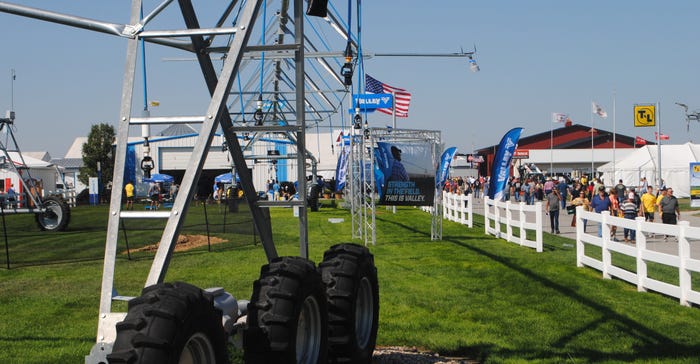
When Frank Zybach first developed his center pivot prototype in 1947, while working as a tenant wheat farmer in Strasburg, Colo., he was just trying to figure out a way to take the backbreaking labor out of irrigating crops.
Zybach, who died in 1980 and is buried at St. Bonaventure cemetery in Columbus, Neb., probably never realized in his lifetime how much his invention would change the landscape and overall productivity of American agriculture — and agriculture around the world.
Zybach, the farmer who is often touted as the “father of the center pivot,” was inducted into the National Inventors Hall of Fame in 2020. He is being formally inducted May 5, 2022, in Washington, D.C. The induction was delayed because of COVID-19.
Historic pivot
Before the pivot came onto the scene into the early 1940s, most crops were watered by gravity flow irrigation, which would have involved shovels and ditches or moving pipe into place by hand.
Zybach’s first attempt at a center pivot system was built on skids. It was comprised of two sections of pipe that were suspended by cables above the crop field from two towers, with sprinkler heads watering along the length of the pipeline.
The real breakthrough from his prototype came in 1949 with a pivot that included five towers with pipes running on steel wheels that could irrigate 40 acres. This evolved with his addition of water valves for siphoning pressurized water from the main pipe to drive the wheels and maintain tower alignment if one of the towers lagged behind the others.
On July 22, 1952, Zybach was granted U.S. patent 2,604,359 for his “self-propelled sprinkling irrigating apparatus,” which we know today as the center pivot. That patented version of the pivot was large enough — complete with a 600-foot boom — to irrigate a 135-acre circle, or basically a standard 160-acre quarter-section of land, without the corners.
Young inventor
Zybach was born in 1894 in Lafayette, Ore. When he was only 3 months old, the family moved to Nebraska, where his father operated a blacksmith shop. He attended formal schooling until the seventh grade, but he was always helping his father. His mind was working and innovating, even at an early age.
Zybach was granted 10 patents in his lifetime. He filed for his first patent at age 13, for a tractor guide that would keep a tractor going in concentric circles as it pulled a plow — an invention that could be considered a precursor to the modern autonomous equipment. He built an automatic transmission that was nearly purchased by Chrysler.
After development of his initial pivot system, Zybach moved back to Nebraska and partnered with Columbus auto dealer A. E. Trowbridge in the opening of a small manufacturing business, in order to build, market and install his pivots.
By 1954, the patent rights were licensed to Robert Daugherty, the president of Valley Manufacturing Co. (now Valmont Industries), a business that had been producing farm elevators. The engineers at Valley modified and refined Zybach’s design, making it sturdier, taller and more reliable. In 1955, Valley produced seven pivots, but by 1960, they were producing 50 a year.
New plan
After licensing the patent to Valley, Zybach and Trowbridge were far from idle. They set out to buy inexpensive land around Atkinson, Neb., in Holt County, where they installed center pivots, essentially adding to the value of farmland.
But the impact of those early pivots in Holt County was far greater than financial for Zybach. Don Fling of Ainsworth was only 10 years old in 1961 when Zybach and a crew from Valley installed a seven-tower water-drive 1031 Valley pivot system on his father’s farm.
Nebraska Farmer visited with Fling in 2013 about that experience. Fling’s father, Glen, had purchased one of the first pivots in Brown County for about $7,000, and he would go on to buy another 13-tower model 1041 Valley in 1965. The reason the family was sold on the Valley pivots was they had watched them in action on Zybach’s land near Atkinson.
In 2013, Fling still had a 1976 Valley water-drive, complete with steel wheels, irrigating part of his cropland. He had new pivots on his land, but he kept the water-drive running. He said that the original 1031 model pivot had operated on their farm until 1992, watering corn, alfalfa and small grain.
New tech
Of course, pivots today have come a long way since the days of the water-drive Valley pivots that Zybach’s hands were so deeply involved in making. Today, all of the major center pivot manufacturers continue to call Nebraska home, developing new innovations to the Zybach concept, new ways to use the pivot, and remote methods to monitor and control it. Innovations that continue to develop at rapid pace might be a surprise to Zybach if he were alive today.
His invention helped change the trajectory of irrigation technology. In the 1970s, there were about 3,000 pivots in operation in Nebraska, while most irrigated acres were still gravity flow. Today, thanks to Zybach’s innovation, there are well over 55,000 pivots in operation in Nebraska alone, covering the vast majority of the state’s 8.6 million irrigated acres.
But pivots also are in operation across the U.S. and around the world, including parts of Spain, Australia, New Zealand, Brazil and even desert areas in the Sahara, the Middle East and far beyond.
About the Author(s)
You May Also Like






